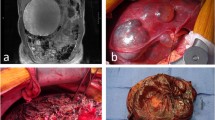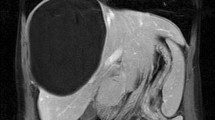Abstract. Nonparasitic cysts of the liver (NPHC) are highly variable in respect to appearance and therapeutic approach. The treatment of these cysts varies according to the nature and appearance of the disease. Based on the variable nature of disease and the various therapeutic options, all of which were attempted in our patients, the most suitable mode of treatment for different forms of NPHC are discussed. Ninety-one patients with NPHC who had been treated surgically from 1977 through 1995 were examined retrospectively. Asymptomatic peripheral cysts measuring up to 10 cm do not require further treatment. Computed tomography (CT)-guided aspiration (
n = 9) should be regarded as a palliative measure. Within a short period, CT-guided aspiration led to recurrence of symptoms in seven of our patients. Standard treatment of NPHC is fenestration with widest possible excision of the cystic wall, which can be performed laparoscopically ( n = 10) or by the conventional surgical mode ( n = 54). One patient was initially operated by the laparoscopic technique but developed bleeding, which necessitated conversion to the open mode. Three patients underwent synchronous laparoscopic cholecystectomy. Recurrence rates were similar: 11% in the laparoscopically treated group and 13% in the group that underwent conventional open surgery. Conventional surgical treatment was always successful in cases of solitary cysts. However, in cases of multiple cysts measuring more than 5 cm, conventional surgery was followed by recurrence of symptoms in 26% of patients (7/27), who then had to undergo a second operation. Partial resection of the liver ( n = 9) was successfully performed in cases of polycystic disease ( n = 5) with concomitant enlargement of the organ as well as in cases of large solitary cysts of the left lobe of the liver ( n = 4). In patients in whom we found that the cysts communicated with the ductal system ( n = 3), we performed a cystojejunostomy to drain the bile. The complication rate was low. In addition to frequent postoperative ascites, which necessitated no further intervention, we observed infectious complications in four patients. Twenty patients (22%) expired during a mean follow-up period of 6.2 years. Interestingly, deaths were frequently associated with malignancy (11/20). After fenestration of multiple cysts measuring > 5 cm, the patients are at high risk for recurrence. Hence partial resection of the liver is an excellent therapeutic alternative in selected patients with polycystic disease and massive enlargement of the organ in whom the disease could not be controlled by simple fenestration. The results of this study show that laparoscopic fenestration should replace the conventional surgical technique as the gold standard in cases of NPHC because the laparoscopic technique is less stressful for the patient and is associated with a rate of success similar to that of the conventional technique.
Similar content being viewed by others
Author information
Authors and Affiliations
Rights and permissions
About this article
Cite this article
Koperna, T., Vogl, S., Satzinger, U. et al. Nonparasitic Cysts of the Liver: Results and Options of Surgical Treatment. World J. Surg. 21, 850–855 (1997). https://doi.org/10.1007/s002689900316
Issue Date:
DOI: https://doi.org/10.1007/s002689900316




